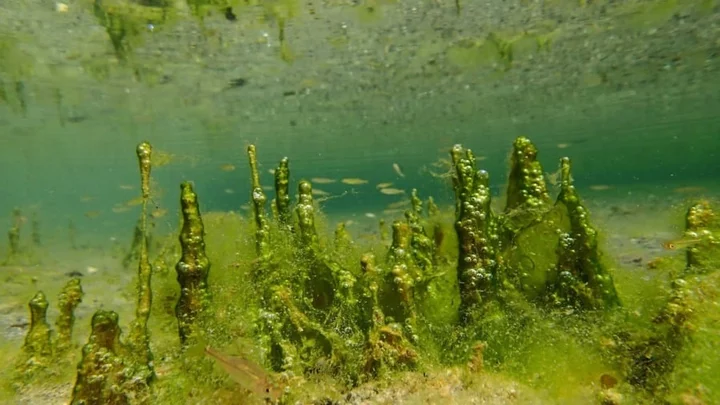Example of a potentially toxic bloom of cyanobacteria. (Photo credit: Rich Fadness and Keith Bouma-Gregson, NCRWQCB)
Humboldt County Department of Health and Human Services press release:
Environmental health officials are reminding community residents to be on the lookout for harmful algal blooms after two dogs died a short time after swimming in a small pool off the Eel River near Fernbridge on Thursday, Sept. 5.
Warm water and abundant nutrients can cause cyanobacteria, sometimes called blue-green algae, to grow more rapidly than usual causing “blooms.” These blooms are termed “harmful algal blooms,” or HABs, and can produce toxins and taste and odors that cause health risks to humans and animals.
Freshwater HABs can appear as dark green, blue-green, black, orange or brown water or can occur as mats and sometimes create scum or foam on the riverbed or on the water. However, toxins produced by HABs may be present without visual indicators.
Typically, cyanobacteria warnings come out between late July and early August, coinciding with low flows and sustained high temperatures in the inland areas which may contribute to cyanobacteria growth in local rivers and lagoons.
Since 2001, there have been 12 documented dog deaths locally where the dogs died shortly after swimming in Big Lagoon, the South Fork Eel River or the Van Duzen River. In each instance, water samples confirmed the presence of cyanobacteria in the water. Additionally, in July 2021, the confirmed presence of cyanobacteria in the Trinity River east of Willow Creek is believed to have contributed to a dog’s death that had occurred weeks before.
Most algal blooms in California contain harmless green algae, however, it is difficult to test and monitor the many miles of local rivers with conditions that readily change. To stay safe, it is best to assume that all algal blooms have the potential to contain toxins.
Officials recommend the following guidelines for recreational users of freshwater areas:
- Keep children, pets and livestock from swimming in or drinking water containing algal scums or mats—especially those occurring in slow or stagnant water.
- Rinse your dog with clean water after swimming as toxins may still be present on their fur.
- Adults should also avoid wading and swimming in water containing algal blooms. Try not to swallow or inhale water spray in an algal bloom area.
- If no algal scums or mats are visible, you should still carefully watch young children, warn them not to swallow any water and bathe with clean water after swimming.
- Fish should be consumed only after removing the guts and liver and rinsing fillets in tap water.
- Never drink, cook with or wash dishes with water from rivers, streams or lakes.
- Get medical attention immediately if you think that you, your pet or livestock might have been poisoned by cyanobacteria toxins. Be sure to tell the doctor or veterinarian about possible contact with cyanobacteria or algal blooms.
To learn more about cyanobacteria and harmful algal blooms, visit the state of California’s website at www.mywaterquality.ca.gov/habs/index.html.
- Join or support one of the many watershed and river organizations.
To report a bloom, e-mail CyanoHAB.Reports@waterboards.ca.gov or call 844-729-6466 (toll free). Blooms can also be reported via the “bloomWatch” app which is available for free download on iTunes or Google play.
For information on conditions in Humboldt County, contact the Humboldt County Department of Health & Human Services Division of Environmental Health at 707-445-6215 or 800-963-9241. Photos of suspected blooms can also be emailed to envhealth@co.humboldt.ca.us.
Example of a potentially toxic bloom of cyanobacteria. (Photo by Rich Fadness and Keith Bouma-Gregson, North Coast Regional Water Quality Control Board [NCRWQCB])
Anabaena, a toxin-producing cyanobacteria, in and around dying green algae. (Photo by Rich Fadness, NCRWQCB)

CLICK TO MANAGE